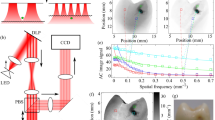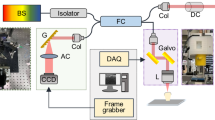Abstract
Dental caries (decay), the most prevalent of diseases, represents a health problem of immense proportions1. It principally affects posterior (back) teeth on occlusal (biting) and approximal (adjacent contacting) surfaces. Caries starts as a subsurface demineralization of enamel, may progress to the underlying dentine and, eventually, to cavitation of the surface. Accurate diagnosis before cavitation would permit targeted preventive treatment, thereby significantly improving dental health and reducing the need for expensive drilling and filling. Inaccessibility of caries initiation sites and recent changes in lesion morphology contribute to the relatively poor accuracy of conventional diagnostic methods2 Among alternative techniques, measurements of electrical resistance3–5 have shown the most promise. Here we describe a new experimental technique that demonstrates an outstanding 100% correlation between a.c. impedance measurements of whole teeth and the actual extent of approximal caries in vitro. Only relatively minor modifications should be required to transfer the technique to in vivo applications.
This is a preview of subscription content, access via your institution
Access options
Subscribe to this journal
Receive 12 print issues and online access
$209.00 per year
only $17.42 per issue
Buy this article
- Purchase on Springer Link
- Instant access to full article PDF
Prices may be subject to local taxes which are calculated during checkout
Similar content being viewed by others
References
Johnson, N.W., The nature of the caries process and the need for markers of risk. in Dental Caries: Markers of High and Low Risk Groups and Individuals. 1–12 (Cambridge Univ. Press, Cambridge, 1991).
Pitts, N.B. The diagnosis of dental caries. 3. Rationale and overview of present and potential future techniques. Dental Update 19, 32–42 (1992).
Mayuzumi, Y., Suzuki, K. & Sumada, J. A method of diagnosing incipient caries In pits and fissures by measuring electric resistance. J. Dent. Res. 43, 941 (1964).
White, G.E., Tsamtsouris, A. & Williams, J. Early detection of occlusal caries by measuring the electrical resistance of the tooth. J. Dent. Res. 57, 195–200 (1978).
Ricketts, D.N.J., Kidd, E.A.M. & Wilson, R.F. A re-evaluation of electrical resistance measurements for the diagnosis of occlusal caries. Br. Dent. J. 178, 11–17 (1995).
Bruce, P.G. Electrical measurements on polymer electrolytes. in Polymer Electrolyte Reviews. Vol 1 (eds. MacCallum, J.R. & Vincent, C.A.) Ch. 8, 237–274 (Elsevier Applied Science, London, 1987).
Bruce, P.G. Fast transport in solids. in Polymer Electrolytes and Intercalation Electrodes (eds. Scrosati, B., Magistris, A., Mari, C.M. & Marietta, G.) 87–107 (NATO ASI series, 1993).
Scholberg, H.P.F., Borggreven, J.M.P.M. & Driessens, F.C.M. A phenonemological interpretation of the frequency-dependent impedance behaviour of bovine dental enamel. Arch. Oral. Biol. 29, 965–970 (1984).
Levenkind, M., Vandernoot, T.J. & Elliot, J.C. Electrochemical impedance characterizationof human and bovine enamel. J. Dent. Res. 69, 1806–1811 (1990).
Levenkind, M., Vandernoot, T.J. & Elliot, J.C. Evaluation of smear layers on serial sections of human dentin by means of electrochemical impedance measurements. J Dent. Res. 71, 426–433 (1992).
Pieper, K., Visser, H., Hulsman, M. & Wahner, M. The testing of an electronic device in the diagnosis of fissure caries. Dtsch. Zahnartd. Z. 45, 721–724 (1990).
Lussi, A. Validity of diagnostic and treatment decisions of fissure caries. Caries Res. 25, 296–303 (1991).
Russell, M. & Pitts, N.B. Radiovisiographic diagnosis of dental caries: Initial comparison of basic mode videoprints with bitewing radiography. Caries Res. 27, 65–70 (1993).
Longbottom, C. The clinical diagnosis of dental caries —; an initial evaluation of novel techniques. PhD thesis, University of Dundee (1992).
Kay, E.J. Factors affecting dental restorative treatment decisions. PhD thesis, University of Glasgow (1991).
Bruce, P.G., Lisowska-Oleksiak, A., Los, P. & Vincent, C.A. Electrochemical impedance spectroscopy at an ultramicroelectrode. J. Electroanal. Chem. 367, 279–283 (1994).
Author information
Authors and Affiliations
Rights and permissions
About this article
Cite this article
Longbottom, C., Huysmans, MC., Pitts, N. et al. Detection of dental decay and its extent using a.c. impedence spectroscopy. Nat Med 2, 235–237 (1996). https://doi.org/10.1038/nm0296-235
Received:
Accepted:
Issue Date:
DOI: https://doi.org/10.1038/nm0296-235
This article is cited by
-
Comparison of novel and established caries diagnostic methods: a clinical study on occlusal surfaces
BMC Oral Health (2021)
-
Effect of self-assembling peptide P11-4 on orthodontic treatment-induced carious lesions
Scientific Reports (2020)
-
Aktuelle Entwicklungen in der Kariesdiagnostik
wissen kompakt (2011)
-
A self-adaptive fluidic probe for electrical caries detection
Biomedical Microdevices (2008)
-
Age-related changes in ac-impedance spectroscopy studies of normal human dentine
Journal of Materials Science: Materials in Medicine (2007)



